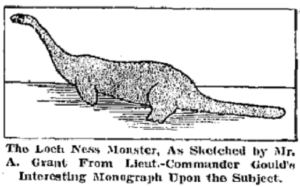Although the Loch Ness monster has been a mythological legend throughout time, the first recorded observation of the creature occurred on August 22, 565. On that date St. Columba, an Irish priest traveling through Scotland, is said to have confronted the beast as it attempted to eat one of his colleagues.

St. Columba raised his hand, made the sign of the cross and told the monster, “You will go no further, and won’t touch the man; go back at once.” Apparently frightened by the saint’s invocation of god, the monster departed in haste—“more quickly than if it had been pulled back with rope.” This, at least, is the account recorded by the historian Adamnan, in his biography of St. Columba, written about a century after the supposed sighting.
If a huge aquatic monster were to pick a place to hide out, Loch Ness would be the perfect choice. The Loch itself is huge—running for about 23 miles at a width of up to a mile and reaching a depth of over 750 feet. It contains more water than all the other lakes of England and Wales put together. The water is tea-colored, stained by the peat soils of the watershed. The Loch, which lies 57 feet above sea level, was an important transportation corridor in Scotland, especially since the Caledonian Canal was built in the mid-1800s. The canal linked several lochs, allowing water-borne transit across the country from East to West and back. Today, however, the canal is used only for recreational purposes—including attempts to see the Loch Ness monster.

The Loch Ness monster, or “Nessie” to its friends, belongs to a group of animals called “cryptids,” which may or may not exist. Cryptids are common in almost all cultures and locations, reflecting basic human fear of and fascination with the unknown in nature. Although some famous cryptids are terrestrial, like Big Foot and the Yeti, most are aquatic. Because humans are short-term visitors at best to the aquatic environment, we are more likely to imagine cryptids lurking in the mysterious deep waters below the surface. Relatives of Nessie are known as Ogopogo in Lake Okanagan in British Columbia, Dobhar-Chu in Ireland, Altamaha in the Central Asian country of Georgia, Akkorokamui in Volcano Bay off the coast of Japan and Tessie in Lake Tahoe.
The legend of the Loch Ness monster is particularly stubborn. A sighting in 1933 launched a tourist industry around the lake. That was followed by the famous photo of the monster’s long neck and head above the water’s surface, taken by a respected surgeon (and, hence, an unquestionably credible observer) in 1934. A 1957 book by Constance Whyte gave a patina of authority to many sightings by “people of integrity who had reported honestly what they had seen in Loch Ness.” Since then, several serious investigations have been undertaken to find the monster. None has succeeded.
Nonetheless, the legend continues. As Lord Chesterton wryly commented, “Many a man has been hanged on less evidence than there is for the Loch Ness Monster.”
References:
Graves, Dan. 2007. Columba Encounted Loch Ness Monster. Christianity.com. Available at: http://www.christianity.com/church/church-history/timeline/301-600/columba-encountered-loch-ness-monster-11629714.html. Accessed August 21, 2017.
Jones, Paul Anthony. 2015. 16 Cryptids That Might (Or Might Not) Exist. Mental Floss, posted November 23, 2015. Available at: http://mentalfloss.com/article/58943/16-cryptids-might-or-might-not-exist. Accessed August 21, 2017.
Loch Ness Water. Random Loch Ness Water Facts. Available at: http://www.lochnesswater.co.uk/loch_ness_water_facts.htm. Accessed August 21, 2017.
Lyons, Stephen. 1999. The Legend of Loch Ness. PBS, Nova, posted on January 12, 1999. Available at: http://www.pbs.org/wgbh/nova/ancient/legend-loch-ness.html. Accessed August 21, 2017.
